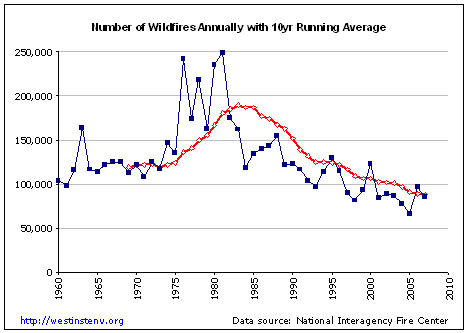 |
| Number of wildfires in the US have declined over the past 50 years of global warming, and were more frequent during the global cooling scare of the 1970's |
 |
| Number of wildfires in Canada are also on a declining trend over the past 40 years of global warming |
 |
| No significant change in total area burned over the past 40 years |
ScienceDaily (July 8, 2011) — How the frequency and intensity of wildfires and intentional biomass burning [biomass burning happens to represent 79% of what the IPCC calls renewable energy] will change in a future climate requires closer scientific attention, according to CSIRO's Dr Melita Keywood.
Dr Keywood said it is likely that fire -- one of nature's primary carbon-cycling mechanisms -- will become an increasingly important driver of atmospheric change as the world warms.
"Understanding changes in the occurrence and magnitude of fires will be an important challenge for which there needs to be a clear focus on the tools and methodologies available to scientists to predict fire occurrence in a changing climate."
She said the link between long-term climate change and short-term variability in fire activity is complex, with multiple and potentially unknown feedbacks.
"Fires require fuel to burn and climate strongly affects the type, quantity and quality of fuel. Periods of high rainfall or high atmospheric carbon dioside [sic] levels may result in increased biomass growth so that fuel loads may be enhanced in future fire seasons.
"Reduced water availability associated with drought may also result in drier biomass that is more readily burned in possibly more intense fires, while higher temperatures and other extreme weather may lengthen fire seasons and result in increased likelihood of fire ignitions and longer burning periods. Vegetation types are also altered in a changing climate.
"In turn, fires influence climate by the emissions to the atmosphere of aerosols and GHG, and by affecting the ability of terrestrial ecosystems to sequester carbon."
Dr Keywood said there is some evidence that fire activity may already be increasing in Western US forests and recent exceptionally intense fire events -- such as the Australian Black Saturday fires in 2009 and Russian fires in 2010 [debunked by NOAA as a natural phenomenon] -- highlight the devastation resulting from fires associated with extreme weather.
"The impacts of emissions from fires on global atmospheric chemistry, and on the atmospheric burden of greenhouse gases and aerosols, are recognised but gaps remain in our scientific understanding of the processes involved and the environmental consequences of fires.
"While significant uncertainty remains in the long-term impacts of forest fires on climate, new sophisticated observational and modelling tools have recently become available. These tools provide insight into changing wildfires and intentional biomass burning emissions on the current and future climate.
"Wildfires and biomass burning are important for a range of international and domestic policies -- from air pollution to climate, poverty, security, food supply, and biodiversity.
"These feedbacks between fire and climate change reinforce the need for fire-related research [which happens to be the research in which Dr. Keywood obtains grant funding] that is based on scientifically sound measurements and modelling" she said.
Dr Keywood's presentation was based on a paper, "Fire in the Air -- Biomass burning impacts in a changing climate," just published in the journal Critical Reviews in Environmental Science and Technology, co-authored by scientists from senior international atmospheric research agencies in the Australia, the US, Norway, Greece, Italy, Switzerland and Germany.
Silly Goose!
ReplyDeleteDon't you know that anthropogenic CO2 causes ALL (real AND imagined) anomalies in the natural world (as well as anything else that might whip up mass hysteria among the hopelessly ignorant and the terminally gullible)?
http://www.numberwatch.co.uk/warmlist.htm
http://www.google.com/url?sa=i&source=images&cd=&cad=rja&docid=8aatHD6832G8ZM&tbnid=__lj3ekRrtHa5M:&ved=0CAgQjRwwAA&url=http%3A%2F%2Fwattsupwiththat.com%2F2012%2F06%2F28%2Fwhat-global-warming-really-looks-like-michael-oppenheimer-fail%2F&ei=nNTRUe7iAsOniQL06YDYBQ&psig=AFQjCNHgaz7TH5ZvM8J5Z1Qlzsw8vej8iA&ust=1372792348093542
ReplyDeletehttp://www.real-science.com/wildfires-dropping-10-decade
ReplyDeletehttp://www.kaltesonne.de/?p=12472
ReplyDelete